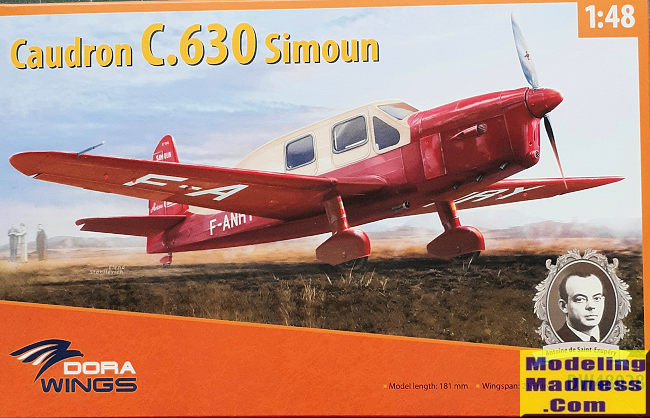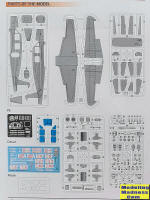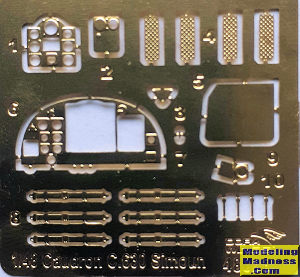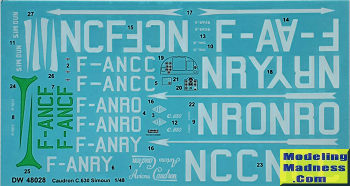
| KIT #: | DW 48028 |
| PRICE: | $45.00 |
| DECALS: | Four options |
| REVIEWER: | John Summerford |
| NOTES: |

| HISTORY |
The C.630 Simoun (desert dust storm) was an elegant low-wing cantilever monoplane of wooden construction. The wings were plywood plus fabric covered and incorporated flaps from inboard of the ailerons to the wing root. The slab-sided fuselage had light alloy covering for the carefully streamlined curved underside and roof. The non-retractable landing gear had legs with oleo-pneumatic shock absorbers. The tail wheel castored and all three wheels were spatted. Differential brakes were standard.
In mid-1935, deliveries began of the C.630 sporting a 180 hp (134 kW) Renault 6Pri (or 6Q-07) driving a Ratier variable-pitch metal propeller. The new type quickly gained orders from 70 private owners. Air Bleu, the air-mail subsidiary of Air France, ordered 12 airframes and established France's first regular air mail service, each in an elegant royal blue finish with a silver arrow along the fuselage side. They delivered 45 million letters prior to WWII. Other Simouns flew air mail routes in Madagascar.
Antoine de Saint-Exupéry
Antoine Marie Jean-Baptiste Roger, comte de Saint-Exupéry, simply known as de Saint-Exupéry was born on 29 June 1900. He was a French writer, poet, aristocrat, journalist and pioneering aviator. He became a laureate of several of France's highest literary awards and also won the United States National Book Award. He is best remembered for his novella The Little Prince (Le Petit Prince) and for his lyrical aviation writings, including Wind, Sand and Stars and Night Flight.
Saint-Exupéry was a commercial pilot before World War II, working airmail routes in Europe, Africa, and South America. In September 1935, he took ownership of Simoun serial number 7042. After several trips in Africa, he decided at the end of December to fly from Paris to Saigon to establish a new record. After 19 hours and 38 minutes of flight, while cruising by night over the Libyan desert, the crew encountered poor weather conditions with heavy rain falls. The crew decided first to climb to 2,500 meters but the cumulus clouds were still there so he reduced his altitude to 1,000 meters then 400 meters and lower until the aircraft struck the sandy ground. Both occupants were uninjured but walked four days without water or food before being rescued. The aircraft was written off.
At the start of WWII, Saint-Exupéry joined the French Air Force, flying reconnaissance missions until France's armistice with Germany in 1940. After being demobilized from the French Air Force, he travelled to the United States to help persuade its government to enter the war against Nazi Germany. Saint-Exupéry spent 28 months in America, during which he wrote three of his most important works, then joined the Free French Air Force in North Africa—although he was far past the maximum age for such pilots and in declining health. He disappeared on a reconnaissance mission piloting a P-38 from Corsica over the Mediterranean on 31 July 1944.
| THE KIT |
 A
single bag holds all the goodies. Two more bags are enclosed with the five spues
of light gray plastic. One bag holds the decal sheet, photo-etch fret and vinyl
masks. The second bag has the clear parts and yet another bag holding a resin
rudder. My example has some flash on some of the parts, the first time I have
encountered that in a Dora Wings Kit. Surface detail on the exterior parts is
very nice.
A
single bag holds all the goodies. Two more bags are enclosed with the five spues
of light gray plastic. One bag holds the decal sheet, photo-etch fret and vinyl
masks. The second bag has the clear parts and yet another bag holding a resin
rudder. My example has some flash on some of the parts, the first time I have
encountered that in a Dora Wings Kit. Surface detail on the exterior parts is
very nice.
Total parts count of styrene and photo-etch is 142, but not all are called for to complete the model. Two sets of main landing gear are included as well as two different instrument panels. If you don’t like the raised instrument detail on the panels, you can build one with the photo-etch pieces. A complete engine is included, but the access panels are molded into the fuselage.
The instructions are in a 12-page booklet, including the front and back cover. There is not a narrative about the history of the C.630, or technical information or a reference to Saint-Exupéry, even though there is a portrait of him on the box lid. Assembly is broken down to 28 steps over five pages.
 The next
four pages cover color painting and decaling options. Again, no explanation
about the aircraft is supplied. After searching the internet, I determined that
Saint-Exupéry’s aircraft (F-ANRY) in an ivory over red scheme is the first
option. The second option is silver over green (F-ANCF) flown by Philippe
Tréchot and M. Monteil, who were taking part in an air race from Antananarivo,
the capital of Madagascar, to Paris to establish a new record. Unfortunately,
the pair were killed when the plane crashed near Zanzibar. (I wonder about
modeling crashed aircraft.) The last two options are all-blue airmail planes.
The back cover has a paint color chart listing Mr. Hobby, Tamia, Ammo Mig,
Hataka, and Life Color brands.
The next
four pages cover color painting and decaling options. Again, no explanation
about the aircraft is supplied. After searching the internet, I determined that
Saint-Exupéry’s aircraft (F-ANRY) in an ivory over red scheme is the first
option. The second option is silver over green (F-ANCF) flown by Philippe
Tréchot and M. Monteil, who were taking part in an air race from Antananarivo,
the capital of Madagascar, to Paris to establish a new record. Unfortunately,
the pair were killed when the plane crashed near Zanzibar. (I wonder about
modeling crashed aircraft.) The last two options are all-blue airmail planes.
The back cover has a paint color chart listing Mr. Hobby, Tamia, Ammo Mig,
Hataka, and Life Color brands.
| CONCLUSIONS |
Another interesting aircraft from Dora Wings. Also, another slow-building one. Some of the parts are a bit “fiddly” and clean-up is required. A careful examination of the kit before starting will prove beneficial. (And perhaps taking a deep breath too.)
John Summerford
March 2021 Copyright ModelingMadness.com. All rights reserved. If you would like your product reviewed fairly and fairly quickly, please
contact
the editor or see other details in the
Note to
Contributors.